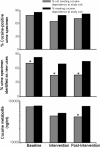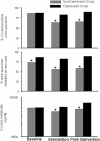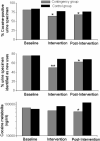Psychosocial functioning and cocaine use during treatment: strength of relationship depends on type of urine-testing method
- PMID: 17624688
- PMCID: PMC2081155
- DOI: 10.1016/j.drugalcdep.2007.05.018
Psychosocial functioning and cocaine use during treatment: strength of relationship depends on type of urine-testing method
Abstract
Although improvement in psychosocial functioning is a common goal in substance-abuse treatment, the primary outcome measure in most cocaine trials is urinalysis-verified cocaine use. However, the relationship between cocaine use and psychosocial outcomes is not well documented. To investigate this relationship and identify the optimal urine-screen method, we retrospectively analyzed data from two 25-week randomized controlled trials of abstinence reinforcement (AR) in 368 cocaine/heroin users maintained on methadone. Cocaine use was measured thrice weekly by qualitative urinalysis, benzoylecgonine concentration (BE), and an estimate of New Uses of cocaine by application of an algorithm to BE. Social adjustment (SAS-SR), current diagnosis of cocaine dependence (DSM-IV criteria), and depression symptoms (Beck Depression Inventory) were determined at study exit. Cocaine use was significantly lower in AR groups than in controls. Across groups, in-treatment cocaine use was significantly associated with worse social adjustment, current cocaine dependence, and depression at exit. Significant differences were detected more frequently with New Uses than qualitative urinalysis or BE. Nevertheless, the amount of variance accounted for by the urine screens was typically <15%. Cocaine use during treatment, especially when measured with New Uses criteria, can predict psychosocial functioning, but cannot substitute for direct measures of psychosocial functioning.
Figures



Similar articles
-
Promoting abstinence from cocaine and heroin with a methadone dose increase and a novel contingency.Drug Alcohol Depend. 2009 Apr 1;101(1-2):92-100. doi: 10.1016/j.drugalcdep.2008.11.006. Epub 2008 Dec 19. Drug Alcohol Depend. 2009. PMID: 19101098 Free PMC article. Clinical Trial.
-
Six-month trial of bupropion with contingency management for cocaine dependence in a methadone-maintained population.Arch Gen Psychiatry. 2006 Feb;63(2):219-28. doi: 10.1001/archpsyc.63.2.219. Arch Gen Psychiatry. 2006. PMID: 16461866 Clinical Trial.
-
A randomized, controlled, pilot trial of methylphenidate and cognitive-behavioral group therapy for cocaine dependence in heroin prescription.J Clin Psychopharmacol. 2013 Feb;33(1):104-8. doi: 10.1097/JCP.0b013e31827bfff4. J Clin Psychopharmacol. 2013. PMID: 23277248 Clinical Trial.
-
Does cannabis use predict poor outcome for heroin-dependent patients on maintenance treatment? Past findings and more evidence against.Addiction. 2003 Mar;98(3):269-79. doi: 10.1046/j.1360-0443.2003.00310.x. Addiction. 2003. PMID: 12603227 Free PMC article. Review.
-
Comparative efficacy and acceptability of psychosocial interventions for individuals with cocaine and amphetamine addiction: A systematic review and network meta-analysis.PLoS Med. 2018 Dec 26;15(12):e1002715. doi: 10.1371/journal.pmed.1002715. eCollection 2018 Dec. PLoS Med. 2018. PMID: 30586362 Free PMC article.
Cited by
-
Cocaine vaccine for the treatment of cocaine dependence in methadone-maintained patients: a randomized, double-blind, placebo-controlled efficacy trial.Arch Gen Psychiatry. 2009 Oct;66(10):1116-23. doi: 10.1001/archgenpsychiatry.2009.128. Arch Gen Psychiatry. 2009. PMID: 19805702 Free PMC article. Clinical Trial.
-
Evaluation of the "Pipeline" for Development of Medications for Cocaine Use Disorder: A Review of Translational Preclinical, Human Laboratory, and Clinical Trial Research.Pharmacol Rev. 2016 Jul;68(3):533-62. doi: 10.1124/pr.115.011668. Pharmacol Rev. 2016. PMID: 27255266 Free PMC article. Review.
-
Pain and suicidality: insights from reward and addiction neuroscience.Prog Neurobiol. 2013 Oct;109:1-27. doi: 10.1016/j.pneurobio.2013.06.003. Epub 2013 Jul 1. Prog Neurobiol. 2013. PMID: 23827972 Free PMC article. Review.
-
What happens in treatment doesn't stay in treatment: cocaine abstinence during treatment is associated with fewer problems at follow-up.J Consult Clin Psychol. 2014 Aug;82(4):619-27. doi: 10.1037/a0036245. Epub 2014 Mar 17. J Consult Clin Psychol. 2014. PMID: 24635550 Free PMC article.
-
Initial validation of a proxy indicator of functioning as a potential tool for establishing a clinically meaningful cocaine use outcome.Drug Alcohol Depend. 2017 Oct 1;179:400-407. doi: 10.1016/j.drugalcdep.2017.07.020. Epub 2017 Aug 14. Drug Alcohol Depend. 2017. PMID: 28858744 Free PMC article.
References
-
- American Psychiatric Association . Diagnostic and statistical manual of mental disorders. American Psychiatric Association; Washington, DC: 1994.
-
- Beck AT, Steer RA. Beck Depression Inventory Manual. The Psychological Corporation/Harcourt Brace Jovanovich, Inc.; New York: 1987.
-
- Belendiuk KA, Epstein DH, Schmittner JP, Preston KL. HIV risk taking behaviors in hepatitis C-positive and negative polydrug abusers in drug treatment. The College on Problems of Drug Dependence Abstracts. 2006
-
- Brodaty H, Peters K, Boyce P, Hickie I, Parker GI, Mitchell P, Wilhelm IK. Age and depression. J. Affect. Disord. 1991;23:137–149. - PubMed
-
- Delucchi KL, Batki SL, Moon J, Jacob P,, 3rd, Jones RT. Urine toxicology samples in cocaine treatment trials: how many need to be tested? J. Addict. Dis. 2002;21:17–26. - PubMed
Publication types
MeSH terms
Substances
Grants and funding
LinkOut - more resources
Full Text Sources
Medical
Research Materials

